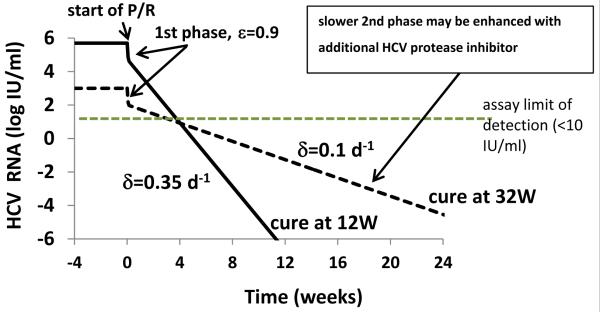Dear Editor,
Perlman and Ehleben’s elegant study1, showed no difference in sustained virological response (SVR) rates with or without boceprevir in patients with HCV genotype-1 and low baseline viral load, LVL (<600,000 IU/ml) who were treated with pegylated-interferon-α (P) and ribavirin (R) and had undetectable HCV-RNA (<10 IU/ml) at week 4 (termed RVR). Perlman and Ehleben’s study suggests that P/R therapy is sufficient in this special population if patients are treated for 24 weeks. However, since triple therapy is expected to be more effective than P/R, the similar SVR rates observed with the two regimens suggests that cure took place much earlier than 24 or 28 weeks of treatment. Thus, treatment duration could be shortened if it were possible to predict the time to cure during lead-in phase.
Viral kinetic analysis during P/R lead-in phase provides a potential means to individualize treatment. The approach is illustrated in Fig.1 using the standard biphasic model2. In general, LVL patients with high baseline HCV-RNA, bHCV (e.g., 500,000 IU/ml) need faster 2nd phase slope of viral decline than patients with extremely low bHCV (e.g., 1,000 IU/ml) in order to reach RVR (Fig. 1 solid and dashed lines, respectively). If both patients in Fig. 1 reach HCV negativity close to week 4, the patient with low bHCV needs much longer duration of therapy (32 weeks) in order to achieve SVR and would benefit from addition of a HCV-protease inhibitor (PI) compared to the patient with high bHCV (12 weeks). Our conservative theoretical approach suggests that the longest treatment duration needed to achieve cure could be estimated for each RVR patient based on their bHCV. Since some patients might reach HCV negativity before week 4, two additional viral-load measurements at day 2 and week 2 would provide more confidence in estimating time to cure by allowing for calculation of the 1st phase of decline and the 2nd phase slope
Figure 1.
Perlman and Ehleben’s exciting results indicate that patients with LVL can skip the addition of PI if they achieve an RVR after a lead-in phase of 4 weeks with P/R. Our modeling data suggests that the duration of therapy and need for a PI can be further individualized by viral kinetic analysis during the P/R lead-in phase. Further studies will be needed to verify this prediction.
Acknowledgments
NIH grants R56/R01-AI078881 and P20-GM103452 and the U.S. Department of Energy contract DEAC52-06NA25396.
Cited articles
- 1.Pearlman BL, Ehleben C. Hepatitis C genotype 1 virus with low viral load and rapid virologic response to peginterferon/ribavirin obviates a protease inhibitor. Hepatology. 2013 doi: 10.1002/hep.26624. in press. [DOI] [PubMed] [Google Scholar]
- 2.Neumann AU, Lam NP, Dahari H, Gretch DR, Wiley TE, Layden TJ, et al. Hepatitis C viral dynamics in vivo and the antiviral efficacy of interferon-alpha therapy. Science. 1998;282:103–107. doi: 10.1126/science.282.5386.103. [DOI] [PubMed] [Google Scholar]
- 3.Guedj J, Perelson AS. Second-phase hepatitis C virus RNA decline during telaprevir-based therapy increases with drug effectiveness: implications for treatment duration. Hepatology. 2011;53:1801–1808. doi: 10.1002/hep.24272. [DOI] [PMC free article] [PubMed] [Google Scholar]
- 4.Dahari H, Lo A, Ribeiro RM, Perelson AS. Modeling hepatitis C virus dynamics: Liver regeneration and critical drug efficacy. J Theor Biol. 2007;247:371–381. doi: 10.1016/j.jtbi.2007.03.006. [DOI] [PMC free article] [PubMed] [Google Scholar]



